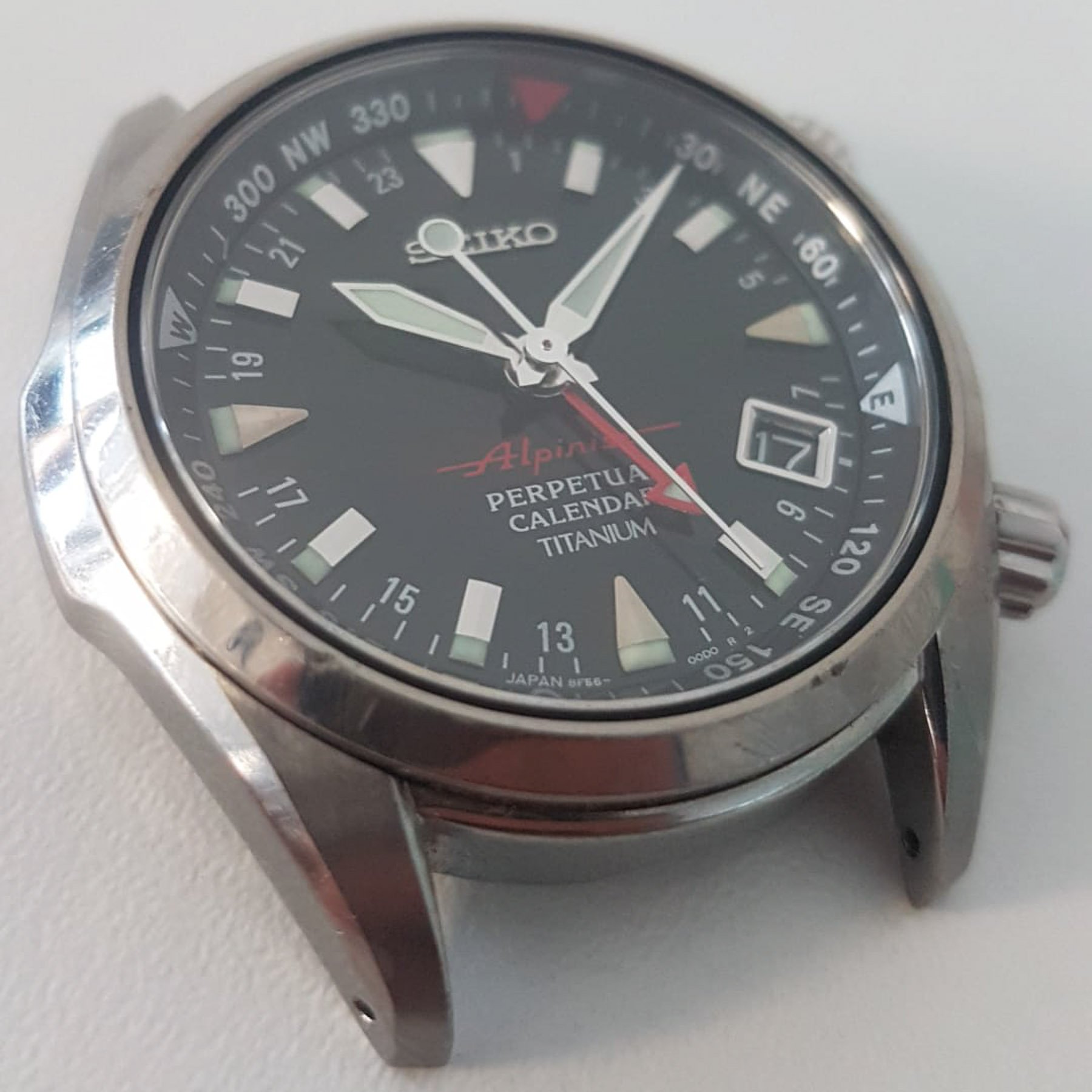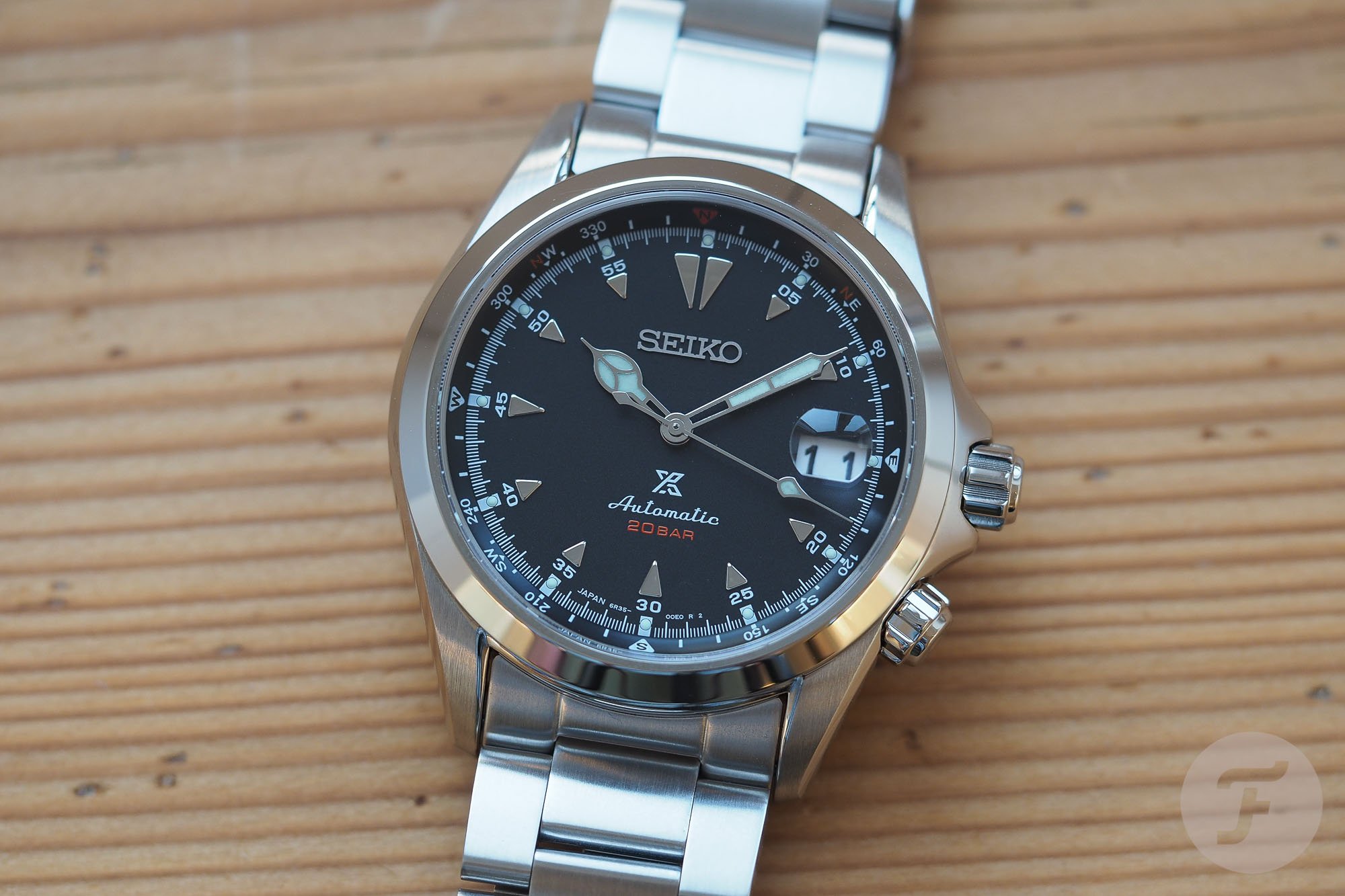A Look Back On The Modern Seiko Alpinist
We’re big fans of all things Seiko here on Fratello. Up until now, we’ve covered almost all the notable lines from the brand, but it’s high time that we give the modern Seiko Alpinist its due.
The Seiko Alpinist is a fascinating watch. It’s a watch that was originally conceived for adventurers. As you’ll read below, it started off as a simple piece during the late 1950s and early ’60s. Then, after an incredibly long absence, it returned as a far more formidable timepiece with greater capability. Today, we’ll spend the bulk of our time focusing on this more recent era with a focus on models with twin crowns and an internal compass bezel. First, though, let’s briefly set the table with a look at the earliest pieces. Incidentally, our recent coverage of the new SPB15X Alpinist models heralds the return of a simpler line.
The Early Seiko Alpinist Period
The Seiko Alpinist debuted way back in 1959 as part of the Laurel series. As you can see above — or read about in a detailed article — these watches were essentially dress watches with more lume and a bit of water resistance. Seiko intended these for mountaineers, so legibility was of primary importance.
During the early 1960s the Alpinist joined the Champion line. Again, they were little more than dress watches with mild sporting intentions (albeit highly attractive ones!). And then, poof, the Alpinist disappeared in the mid 1960s.
The Modern Seiko Alpinist
For a model that’s so popular today, it’s amazing to think that the Seiko Alpinist disappeared for nearly 30 years! It took until 1995 for the vaunted name to return. And when it came back, it did so in a very different way. Seiko set about creating a new identity for the Alpinist by giving it a look that is still here today.
The dress watch looks were gone and in their place came cathedral hands, a second crown to operate the hallmark internal rotating compass bezel at 4 o’clock. Seiko also made sure that these watches could withstand more than just a mountain drizzle. A screw-down crown heralded 200 meters of water resistance. Let’s walk through a few key models since 1995 (and please head to The Spring Bar for an even deeper look).
The Red SCVF Seiko Alpinist
The first modern Seiko Alpinist is a true collector favorite these days. The models that came in 1995 are now known as “Red Alpinists” due to the red Alpinist font on the dial. These watches nailed down a look that really hasn’t changed in the 25 years since that time, so they’re certainly modern classics. These stainless models came in at roughly 38mm in diameter and were fitted with the 25-jewel, 4S15 automatic. This movement was an interesting play because at the time because Seiko was doing its best to shed its “quartz-only” reputation. As such, the 4S15 can be hand-wound, hacks, and runs at a semi hi-beat frequency of 28,800vph.
The Red Seiko Alpinist came in three flavors. There was the SCVF005 in black with chevron indices, the SCVF007 in cream, and the SCVF009 in green. The latter two used applied Arabic numerals at each hour. Consistency wise, Seiko has stuck with the same index combinations and dial colors until today. As mentioned, these watches boasted 200 meters of water resistance, a Hardlex mineral crystal, and came on a bracelet or a brown leather strap. These days, an SCVF in decent condition begins in the $700 range and they go up from there.
The Seiko Alpinist 8F56 GMT Titanium Perpetual Calendar
Eight years later in 2003, an additional line of Seiko Alpinist models joined the fray. If you’ve read about the quartz perpetual calendar Seiko diver I own, then this Alpinist won’t come as a surprise to you. The diver kept things simple with time and date, but the Alpinist added a GMT function on top of the perpetual calendar. The quartz movement is known as the 8F56 and it’s a doozy with accuracy around +/- 2 seconds per month! These watches have 100 meters of water resistance, sword style hands, and slightly different crown positioning. Again, Seiko produced three different “normal” references with the SBCJ019 (black on bracelet), SBCJ021 (cream on bracelet), and SBCJ031 (cream on a strap).
Seiko also issued the sublimely rare 500-piece SSASS limited edition with a blue dial for charity. Any of these 8F56 models are expensive ($1,000+), but the SSASS runs in the thousands. We’re fortunate that our friend Patrick Tacq lent photos of his SSASS and other Alpinist models for the story.
Bridging to today with the SARB Seiko Alpinist series
In 2006, Seiko replaced its Red Alpinist models with the so-called SARB series. If you think about a modern Seiko Alpinist — especially in green — the chances are good that it’s a recent SARB model (the photo above is from a very nice review on The Watch Review Blog). These watches were massively popular until their cancellation within the last couple of years. In fact, the green SARB017 often showed up, and still comes up, on lists of best all-around affordable watches. These pieces came with the then-new 6R15 movement. In some ways, it was a demotion versus the 4S14 with its 21,600vph, but it brought 50 hours of power reserve instead of 40. It officially came in at 39.5mm in diameter and wears wonderfully with a short 46.3mm lug-to-lug.
Once again, these Seiko Alpinist watches had a sapphire crystal and 200 meters of water resistance. Seiko gave it a solid screw-in case back complete with the Alpinist logo, which was now gone from the dial. Once again, there were three regular edition models. The SARB013 came with a cream dial on a bracelet, while the SARB015 came in black on a bracelet and a set of unique hands and indices. The green SARB017 came on brown leather, although I’ve also seen it on a bracelet. Oddly, Seiko chose America as the sole market to receive a send-off limited edition model in 2019 (the 60th anniversary of the Alpinist and, therefore, 1,959 pieces) with the blue SPB089. All of the SARB models have increased in value, but the blue 2019 model is the most revered.
2020 and the newest Seiko Alpinist
It was late 2019 when the newest twin crown Seiko Alpinist models made their way to the internet. I ambled down to the local Frankfurt Boutique and took a closer look. The watches follow the prior SARB formula closely at 39.5mm, but now boast a 70-hour power reserve thanks to the superior 6R35 movement. There’s also a sapphire crystal, display back, and an improved bracelet.
Curiously, there’s no mention of the word “Alpinist” anywhere on the watch. Instead, we get the Prospex symbol on the dial, which actually looks fine on this model. The SPB117 (black on bracelet), SPB119 (white on bracelet), and SPB121 (green on leather) comprise the mainstream global release, while an SPB123 with cream dial, gold indices, and green strap is also available (floating teasingly under the radar). Interestingly, Seiko kept the cathedral hands on all. Dial-wise, all have Arabic numerals, but the black dial has chevron indices. Pricing has also risen to the €700 realm.
What’s next?
Seiko recently dropped simpler three-hand Alpinist models as an extension to the collection. Some are decrying these pieces as “Falpinists”, but I actually think that they’re more faithful to the original formula. Still, the twin crown compass models are destined to continue as the most popular. Even though these models have less than a year under their collective belts, we have to believe that Seiko will begin adding some more variations. Learn more about the brand here.










